Sacred Places
Timeline of U.S. Colonial Policies Impacting Indigenous Spirituality & Sacred Sites
Published
7 years agoon
By
Rudy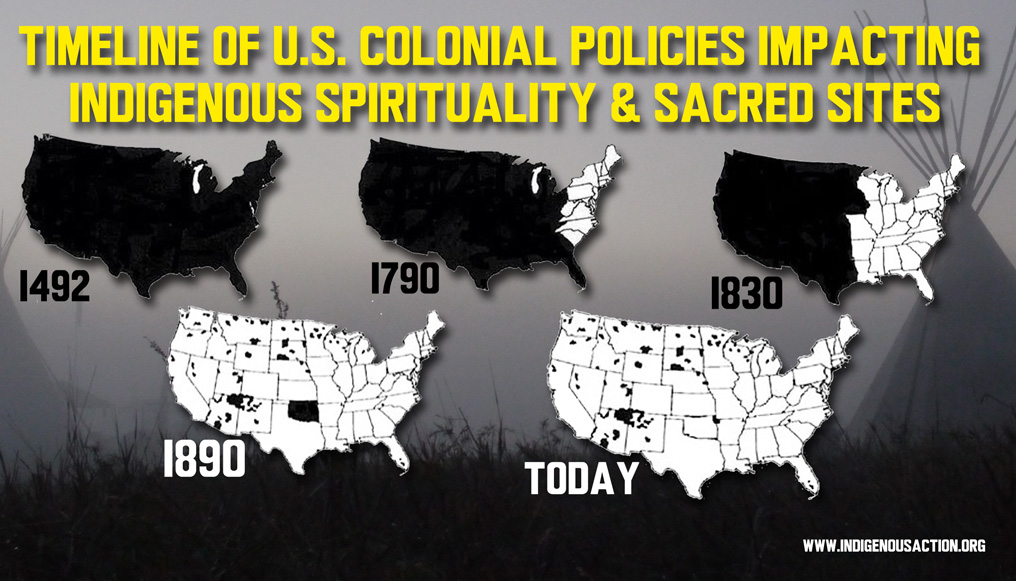
Compiled by: IndigenousAction.org – document will be updated on an ongoing basis.
US policies towards Indigenous Peoples has been a process of social and cultural annihilation.
Indigenous Peoples had no religious rights and traditional ceremonies were banned until 1978.
White invaders feared Indigenous uprisings such as the Ghost Dance which, although a peaceful spiritual practice, elicited so much fear that 300 Lakota men, women and children were massacred by the U.S. Army’s 7th cavalry while gathering for a Ghost Dance at Wounded Knee on Dec. 29, 1890. Northern Paiute spiritual practitioner Wovoka established the Ghost Dance movement as a way to unify Indigenous Nations, reject colonial invasion and continue our struggle for the liberation of Mother Earth.
Throughout U.S. history, the settler government has attempted to eradicate Indigenous existence through genocide and forced assimilation. Even its supposedly most human form, U.S. policy toward indigenous nations attempts to “kill the Indian and save the man,” through a range of tactics including; boarding schools, language prohibition, and criminalization of ceremony.
These practices were codified in treaties well before Andrew Jackson’s Indian Removal Act of 1830 which precipitated forced relocations in mass of entire Nations, such as The Trail of Tears. Approximately fifty-three different forced marches occurred between August 1863 and the end of 1866.
1492:
Columbus performed a ceremony in which members of his crew read aloud a declaration of settlement in the name of the King and Queen of Spain on behalf of the Church, to “legally” “take possession” of all lands “discovered,” meaning all lands not occupied by Christians.
1493:
The Papal Bull “Inter Caetera,” issued by Pope Alexander VI on May 4, 1493, played a central role in the Spanish invasion. The document, which established the “The Doctrine of Discovery,” supporting Spain’s Christian strategy to ensure its “exclusive right” to the peoples enslaved and lands invaded by Columbus the previous year. This decree also expressed the Pope’s threat to forcibly assimilate Indigenous Peoples to Catholicism in order to strengthen the “Christian Empire.”
1500’s:
Spanish invaders establish Catholic missions in an area extending from New Spain (today’s “Mexico”) and the Southwestern portions of what today are the “United States,” and as far as South as Argentina and Chile. As part of a policy of military conquest and pacification, genocidal campaigns were waged by “conquistadores” (Conquerors) who sought to establish resource colonies and propagate the their “faith” through the establishment of Christian “missions.” Church run and controlled plantations, in which native slave labor was central to its operation.
1823:
The Doctrine of Discovery was written into U.S. law as a way to deny land rights to Indigenous Peoples in the Supreme Court case, Johnson v. McIntosh. In a unanimous decision, Chief Justice John Marshall wrote that Christian European nations had assumed complete control over the lands of “America” during the “Age of Discovery.” Upon declaring “independence” in 1776, he noted, the U.S. inherited authority over these lands from Great Britain, “notwithstanding the occupancy of the natives, who were heathens…” According to the ruling, Indigenous Peoples did not have any rights as independent nations, but only as tenants or residents of U.S. land. To this day, Johnson v. McIntosh has not been overruled.
1824:
The Bureau of Indian Affairs (BIA) founded by Secretary of War John C. Calhoun, who created the agency as a division within his department.
1849:
The United States Department of the Interior (DOI) founded. It is responsible for the management of most federal land and natural resources and the administration of programs relating to Indigenous Peoples. About 75% of federal “public land” is managed by the department, with most of the remainder managed by the Agriculture Department’s United States Forest Service.
1860:
Bureau of Indian Affairs established the first boarding school designed to brutally assimilate Indigenous children into white settler society. Children were systematically punished for practicing their spirituality or even speaking their language. To this day thousands of indigenous children lay buried in mass and anonymous graves on former school grounds through Canada, the U.S. and Latin America, as a similar model was employed in the Mission system.
1862:
The Homestead Act offered 160 acres of Indigenous lands to white settlers willing to move and live on the “homestead.” This led to the theft of 270 million acres of Indigenous lands including sacred sites.
1887:
The Dawes Act authorized the President of the United States to survey and divide communal Indigenous Lands into allotments for individual Indigenous people. The Dawes Act reduced Indigenous Lands from 138 million acres in 1887 to 78 million in 1900 and facilitated further white invasion and settlement.
1890s through the 1930s, the US colonial government prohibits the exercise of Indigenous religion.
1905:
The USDA Forest Service was established within the Department of Agriculture. The agency was given a unique mission: to sustain healthy, diverse, and productive forests and grasslands for present and future generations.
1906:
The Antiquities Act gives the President of the United States the authority to create national monuments from public lands to protect significant natural, cultural, or scientific features. The act resulted from concerns about protecting Indigenous cultural sites and “artifacts” – collectively termed “antiquities” – on “federal lands” in the West, such as at Chaco Canyon, New Mexico.
1921:
The Office of Indian Affairs issued a policy statement to its agents which stated: “The Sun dance, and all other similar dances and so-called religious ceremonies are considered ‘Indian offenses’ under existing regulations, and corrective penalties are provided. I regard such restrictions as applicable to any (religious) dance which involves… the reckless giving away of property… frequent or prolonged periods of celebration…in fact any disorderly/ or plainly excessive performance that promotes superstitious cruelty, licentiousness, idleness, danger to health, and shiftless indifference to family welfare.”
1924:
United States Congress grants Indigenous Peoples the rights of citizenship, including the right to vote, however Arizona, New Mexico, Utah, and Colorado do not recognize the right to vote until 1948.
1934:
The Dawes Act abolished. US Congress passes the Indian Reorganization Act to replace policies of assimilation and the breakup of Indigenous lands with the establishment of Tribal Councils to further resource colonialism.
1935:
The Historic Sites Act calls for the preservation of significant national, historical and archaeological properties, the designation and acquisition of national historic landmarks and a survey of valuable historic and prehistoric sites.
1946:
Bureau of Land Management established when the Department of the Interior merged two older agencies: the General Land Office, created in 1800 to sell off the public lands and encourage white settlement; and the Grazing Service, created in 1934 to manage grazing on “public lands.”
1948:
Universal Declaration on Human Rights declares that freedom of religion is a fundamental human right. Article 18 reads: “Everyone has the right to freedom of thought, conscience and religion; this right includes freedom to change his religion or belief, and freedom, either alone or in community with others and in public or private, to manifest his religion or belief in teaching, practice, worship and observance.”
1960s:
The United States Forest Service began incorporating a policy of sustained planning and “multiple use” management in an effort to balance grazing, logging and recreation interests.
1966:
Passage of the National Historic Preservation Act (NHPA) which established that, “properties of traditional religious and cultural importance to Indian Tribes or Native Hawaiian organizations (“traditional cultural properties”) may be determined to be eligible for inclusion on the National Register of Historic Places. NHPA’s implementing regulations, 36 CFR Part 800, require Federal agencies to consult with Tribes regarding properties of religious or cultural importance.” In order to achieve its goals, the Act establishes a process (generally referred to as the Section 106 process) whereby federal agencies who are engaged in an undertaking must determine if the undertaking must determine if the undertaking will have an adverse impact upon an historic property (a prehistoric or historic site that is eligible for listing in the National Register of Historic Places). A 1992 amendment provides that “a Federal agency shall consult with any Indian tribe or Native Hawaiian organization that attaches religious and cultural significance” to a property which falls under the Act. The amendment also specifically recognizes that “properties of traditional religious and cultural importance to an Indian tribe or Native Hawaiian organization may be determined to be eligible for inclusion on the National Register.”
1970:
The National Environmental Policy Act (NEPA) was created by US Congress to ensure that federal agencies consider the effects of their proposed actions on the environment. NEPA specifies that the federal government must “preserve important historic, cultural, and natural aspects of our national heritage.” NEPA requires agencies to assess the impact of their activities upon the environment. This impact is normally assessed through the development of Environmental Assessments (EA) and Environmental Impact Statements (EIS). Consultation with and evaluation of the effects upon Indigenous Nations is required yet a federal agency may go forward with the any proposed project notwithstanding its impact.
1971:
“President” Richard M. Nixon signs Executive Order 11593 — “Protection and Enhancement of the Cultural Environment” — requiring all federal agencies to inventory cultural properties on their lands.
1974:
The Archaeological and Historic Preservation Act is passed requiring all federal agencies to conduct archaeological investigations prior to initiating any project that would disturb or destroy significant cultural remains.
1978:
After years of Indigenous advocacy including occupations of federal buildings by A.I.M. (American Indian Movement) and others, the American Indian Religious Freedom Act (AIRFA) is passed by Congress. The primary congressional sponsor of the Act, Senator Abourezk stated, “Representatives of traditional Indian religious societies have sought to protect their rights, to have access to sacred religious sites, to make use of a variety of natural substances and wildlife in the practice of their religion and to secure privacy for sacred ceremonials. Infringement of these rights have consistently occurred due to enforcement of conservation laws which simply failed to take into account their impact on such Indian religious and cultural practices.” This law was originally intended to protect all forms of Indigenous spiritual practices, but the law failed to protect sacred sites in subsequent court tests. AIRFA was a policy statement that had no enforcement power.
[AIRFA] does not mandate protection of Tribal religious practices to the exclusion of all other course of action. It does require that Federal actions be evaluated for their impacts on Indian religious beliefs and practices. (AR Doc. 188; page 3934)
1979:
The Archaeological Resources Protection Act (ARPA) strengthens protection of archaeological resources on federal lands by clarifying and expanding the Antiquities Act of 1906. ARPA regulates the issuance of permits for archeological excavations of archeological sites on federal and Indigenous lands. Indigenous Nations must consent to excavations on their lands and receive notice of excavations on federal lands if the site is of religious or cultural importance.
1981:
UN Declaration on the Elimination of All Forms of Intolerance and of Discrimination Based on Religion or Belief
Article 1(1): “Everyone shall have the right to freedom of thought, conscience and religion. This right shall include freedom to have a religion or whatever belief of his choice, and freedom, either individually or in community with others and in public or in private, to manifest his religion or belief in worship, observance, practice and teaching.”
Article 1(2): “No one shall be subject to coercion which would impair his freedom to have a religion or belief of his choice.”
Article 4(1): “All States shall take effective measures to prevent and eliminate discrimination on the grounds of religion or belief.”
1983:
Wilson v. Block, Hopi and Diné (Navajo) attempt to preclude expansion of a ski area in the San Francisco Peaks, near occupied lands of Flagstaff, Arizona. Indigenous Nations assert that development of the ski area could have a serious and adverse impact upon their cultures and social organization. Abbott Sekaquaptewa, then-chairman of the Hopi tribe, stated, “It is my opinion that in the long run if the expansion is permitted, we will not be able successfully to teach our people that this is a sacred place. If the ski resort remains or is expanded, our people will not accept the view that this is the sacred Home of the Kachinas. The basis of our existence as a society will become a mere fairy tale to our people. If our people no longer possess this long-held belief and way of life, which will inevitably occur with the continued presence of the ski resort … a direct and negative impact upon our religious practices [will result]. The destruction of these practices will also destroy our present way of life and culture.”
This was the first sacred site case to test AIRFA. The Supreme Court ultimately decided against the Indigenous Nations and allowed the ski area to desecrate the sacred site.
1988:
Lyng v. Northwest Indian Cemetery Protective Association. The United States Supreme Court directly considered the issue of the First Amendment protection of sacred sites. The case involved the construction of a road by the Forest Service in Northern California which the government asserted would improve access to timber and recreational resources. The federal trial and appellate courts had ruled in favor of the Indigenous spiritual practitioners, applying a balancing test known as the “compelling interest” test; the courts had held that the negative impact upon the Indigenous religious practices outweighed the government’s interest in building the road. The United States Supreme Court reversed the lower court’s decision, rejecting the application of the compelling interest test to land management decisions by the government decisions by the government. The court ruled that unless (1) there was specific governmental intent to infringe upon a religion or (2) the government’s action coerced individuals to act contrary to their religious beliefs, the First Amendment provided no protection against governmental action which impacted upon, or even destroyed, a Native American sacred site. Along with Wilson v. Block, the Lyng decision further established that AIRFA is not available as an alternative mechanism for judicial protection of sacred sites. The court held that “it has no teeth.” As a result of the Lyng decision where a governmental action threatens a sacred site, an Indigenous spiritual practitioner has no enforceable First Amendment protection based upon a religious freedom claim.
1990:
Native American Graves Protection and Repatriation Act (NAGPRA) established to protect the burial sites and remains of our ancestors.
NAGPRA is signed into law by President George Bush providing procedures for determining cultural affinity for the purposes of reburying Indigenous ancestors and returning burial “artifacts” and sacred “objects.” Specifically, NAGPRA provides that whenever a party intends to intentionally excavate a burial site for any purpose that party must obtain a permit from the agency managing the land where the burial site is located. If federal lands are involved, the site may be excavated only after notice and consultation with the appropriate Indigenous Nation.
Where buried cultural items are inadvertently discovered as part of another activity, such as construction, mining, logging or agriculture, the person who has discovered the items must temporarily cease activity and notify the responsible federal agency in the case of federal land or the appropriate Nation in the case of Indigenous lands.
1990:
Employment Division v. Smith. United States Supreme Court case that held that the state could deny unemployment benefits to a person fired for violating a state prohibition on the use of peyote, even though the use of the drug was part of a religious ritual. Although states have the power to accommodate otherwise “illegal acts” performed in pursuit of religious beliefs, they are not “required” to do so.
1993:
Religious Freedom Restoration Act (RFRA). Congress enacted RFRA which restored the First Amendment compelling interest balancing test rejected by the United States Supreme Court in the Smith case in 1990. Specially, the Act provides that governmental activity may substantially burden a person’s free exercise of religion only if the activity is in furtherance of a compelling governmental interest and is the least restrictive means of furthering that interest. Under this Act, any person whose free exercise is burdened by a governmental activity may seek judicial redress.
RFRA reiterated that governments should not substantially burden religious exercise without compelling justification; and attempted to provide a claim or defense to persons whose religious exercise is substantially burdened by US government. Later amendments codified at 42 U.S.C. 1996a specifically clarified that the use of peyote by an Indigenous person for “bona fide traditional ceremonial purposes” in connection with the practice of a traditional Indigenous religion is lawful.
1993:
Native American Free Exercise of Religion Act was introduced, which included provisions for sacred site protection; however, this was dropped and the section protecting the ceremonial use of peyote use was eventually passed as an amendment to AIRFA in 1994.
1994:
Draft Declaration on the Rights of Indigenous Peoples at the United Nations is proposed.
1996:
“President” Clinton signed Executive Order (E.O.) 13007 on Indian Sacred Sites, to “protect and preserve Indian religious practices.” It requires Federal agencies responsible for the management of Federal lands, to the extent practicable, permitted by law, and not clearly inconsistent with essential agency functions, to accommodate access to and ceremonial use of Indigenous sacred sites by Indigenous spiritual practitioners and to avoid adversely affecting the physical integrity of such sacred sites. Agencies are required to, where appropriate, maintain the confidentiality of sacred sites.
2003:
Sacred land protection legislation was introduced at the federal level and in California. H.R. 5155, The Sacred Lands Protection Act was introduced by Congressman Nick Rahall (D, WV) but failed to pass.
2005:
Navajo Nation, et al v. USFS. Lawsuit addressing ski area expansion and wastewater snowmaking proposal on the San Francisco Peaks. The suit asserts that the proposal would violate the Religious Freedom Restoration Act. in 2008 an appeals court decided, “The only effect of the proposed upgrades is on the Plaintiffs’ subjective, emotional religious experience. That is, the presence of recycled wastewater on the Peaks is offensive to the Plaintiffs’ religious sensibilities…the diminishment of spiritual fulfillment – serious though it may be – is not a ‘substantial burden’ on the free exercise of religion.” The Court dismissed our religious beliefs referring to them as “damaged spiritual feelings.”
In the same decision, three judges filed a dissenting opinion stating that the ruling “misstates the evidence … , misstates the law under the [Religious Freedom Restoration Act], and misunderstands the very nature of religion.” This ruling was affirmed by the US Supreme Court.
2007:
United Nations General Assembly adopted the Universal Declaration on the Rights of Indigenous Peoples. The resolution called for recognition of the world’s 370 million indigenous peoples’ right to self-determination and control over their lands and resources. The adoption of this resolution comes after twenty-two years of diplomatic negotiations at the United Nations (UN) involving its member states, international civil society groups, and representatives of the world’s Indigenous communities.
Article 25 – Indigenous peoples have the right to maintain and strengthen their distinctive spiritual relationship with their traditionally owned or otherwise occupied and used lands, territories, waters and coastal seas and other resources and to uphold their responsibilities to future generations in this regard.
2011:
U.S. Department of Agriculture releases a draft report outlining changes to its policies and procedures for protecting Sacred Sites.
2012:
Five Federal agencies signed a memorandum of understanding (MOU) to, “improve the protection of and Indian access to sacred sites through interagency coordination and collaboration.”
Sept. 9, 2016:
The Department of Justice, the Department of the Army and the Department of the Interiors issues joint statement in response to Indigenous resistance to the Dakota Access Pipeline (DAPL). The statement addresses, “ the need for a serious discussion on whether there should be nationwide reform with respect to considering tribes’ views on these types of infrastructure projects.” The Obama Administration calls for statutory framework revision and initiates consultation with Indigenous Nations though listening sessions.
References:
http://www.fs.fed.us/spf/tribalrelations/sacredsitesmou.shtml, http://www.achp.gov/docs/SS%20MOU%20Action%20Plan%20%20March%205%202013.pdf
https://www.manataka.org/page1965.html
https://fs.usda.gov/Internet/FSE_DOCUMENTS/stelprdb5376042.pdf
https://www.culturalsurvival.org/ourpublications/csq/article/existing-federal-law-and-protection-sacred-sites-possibilities-and-limit
You may like
anti-colonial
New Book: No Spiritual Surrender, Klee Benally
New Book: No Spiritual Surrender: Indigenous Anarchy in Defense of the Sacred is a searing anti-colonial analysis rooted in frontline experience.
Published
6 months agoon
November 18, 2023By
Rudy

NOW AVAILABLE ONLINE & SELECT BOOKSTORES: No Spiritual Surrender: Indigenous Anarchy in Defense of the Sacred
No Spiritual Surrender: Indigenous Anarchy in Defense of the Sacred is a searing anti-colonial analysis rooted in frontline experience. Klee Benally (Diné) unrelentingly agitates against colonial politics towards Indigenous autonomy and total liberation of Nahasdzáán (Mother Earth).
Available now from Detritus Books detritusbooks.com
406 pages | $20 Nonfiction | Paperback Available in select bookshops.
About the author: Klee Benally is a Diné (Navajo) anarchist and undisciplined agitational propagandist. Originally from Black Mesa. Klee currently resides in occupied Flagstaff, Arizona. kleebenally.com, indigenousaction.org
www.detritusbooks.com
Wholesale inquiries: detritusbooks.com
Now booking speaking tour dates: indigenousaction@gmail.com
#indigenouspeoplesday
Indigenous Resistance Teach-in Oct 13, 2023
Published
7 months agoon
September 28, 2023By
Rudy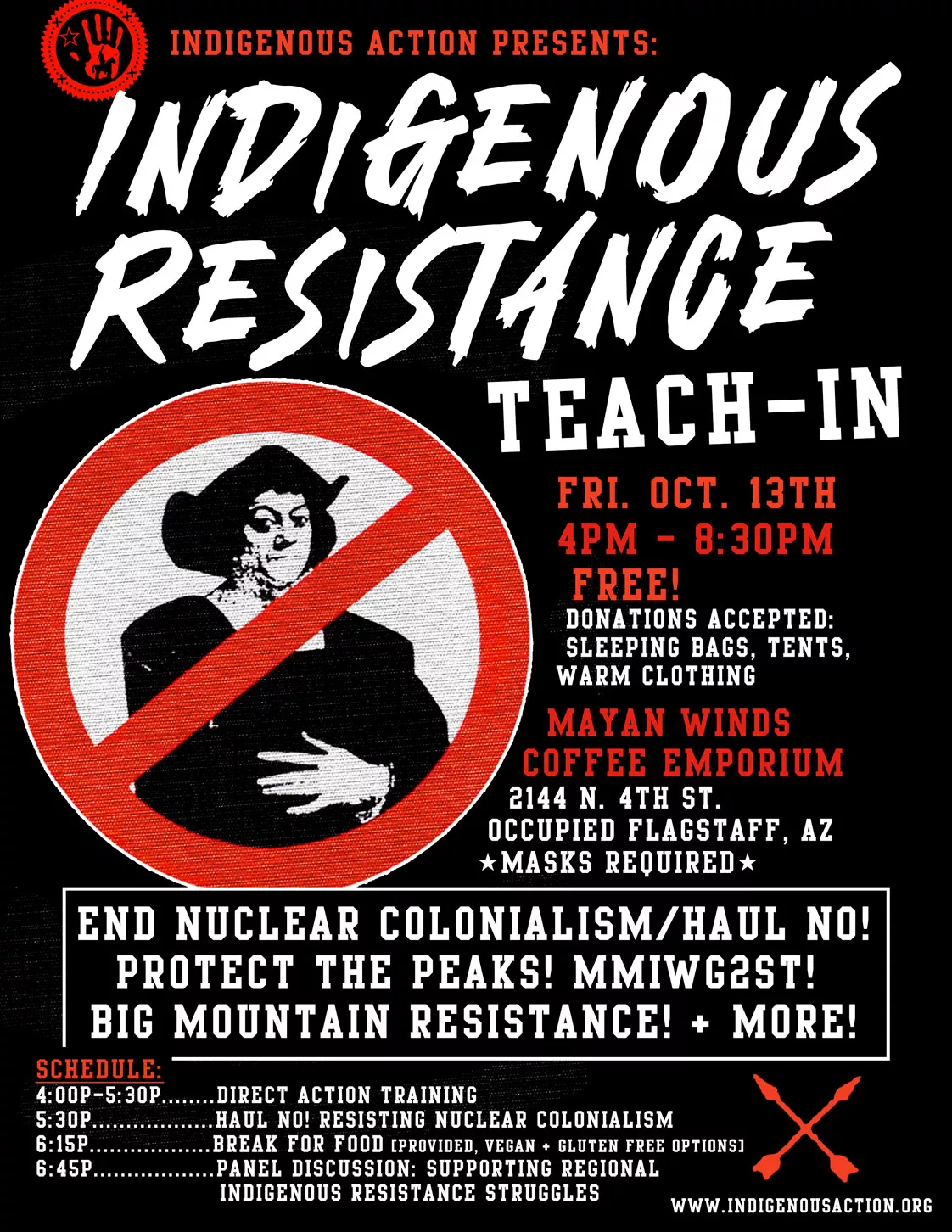

Direct action training, workshop, & panel discussion with Haul No! Protect the Peaks, Indigenous Action, & Louise Benally.
Friday, Oct 13th, 4p-8p
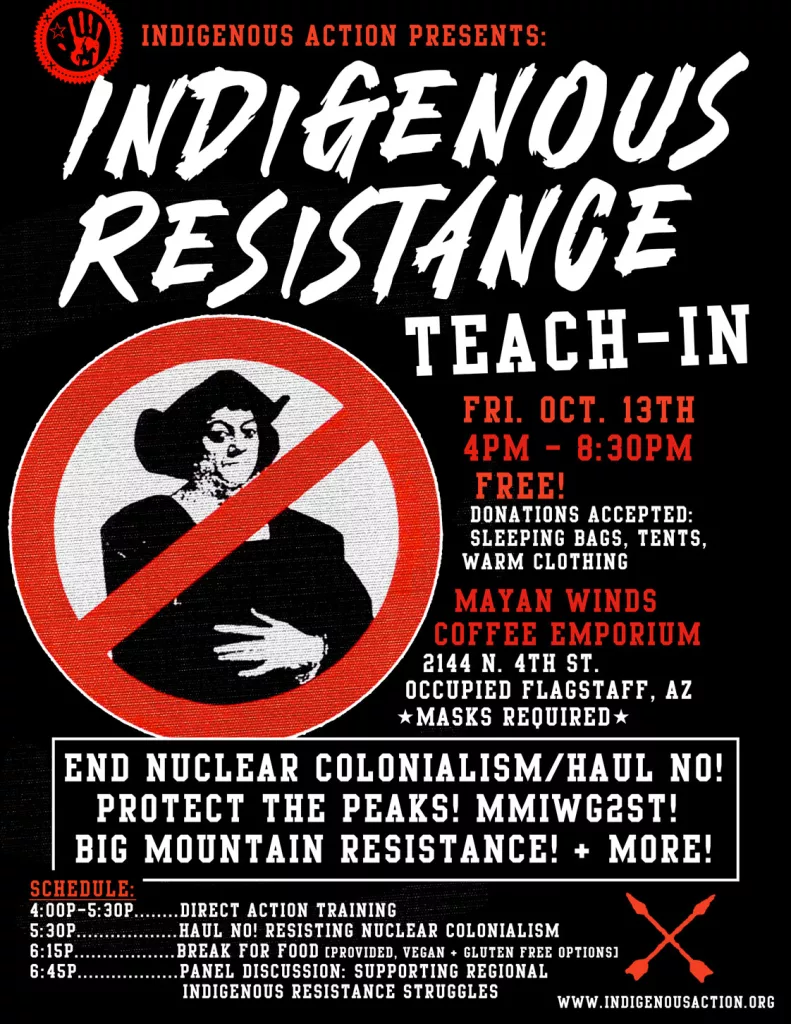

Free (bring a warm clothing/sleeping bag/tent donation for unsheltered relatives).
At Mayan Winds Coffee Emporium
2144 N 4th St. Flagstaff AZ
*Masks required!*
How do whitewashed celebrations of Indigenous Peoples’ Day undermine decolonization?
What ways can you directly support regional anti-colonial struggles?
Schedule:
4:00p-5:30p – Direct Action training
5:30p – Haul No! Resisting Nuclear Colonialism workshop
6:15p – Break for food (Provided, w gluten free & vegan options avail.)
6:45p – Panel Discussion: Supporting Regional Indigenous Resistance Struggles
8:30p – end
Celebrate and support ongoing frontline Indigenous resistance struggles!
#policestate
Ox Sam Camp Raid Update: One Arrested as Prayer Tipis Are Bulldozed and Ceremonial Items Confiscated
Published
11 months agoon
June 9, 2023By
Rudy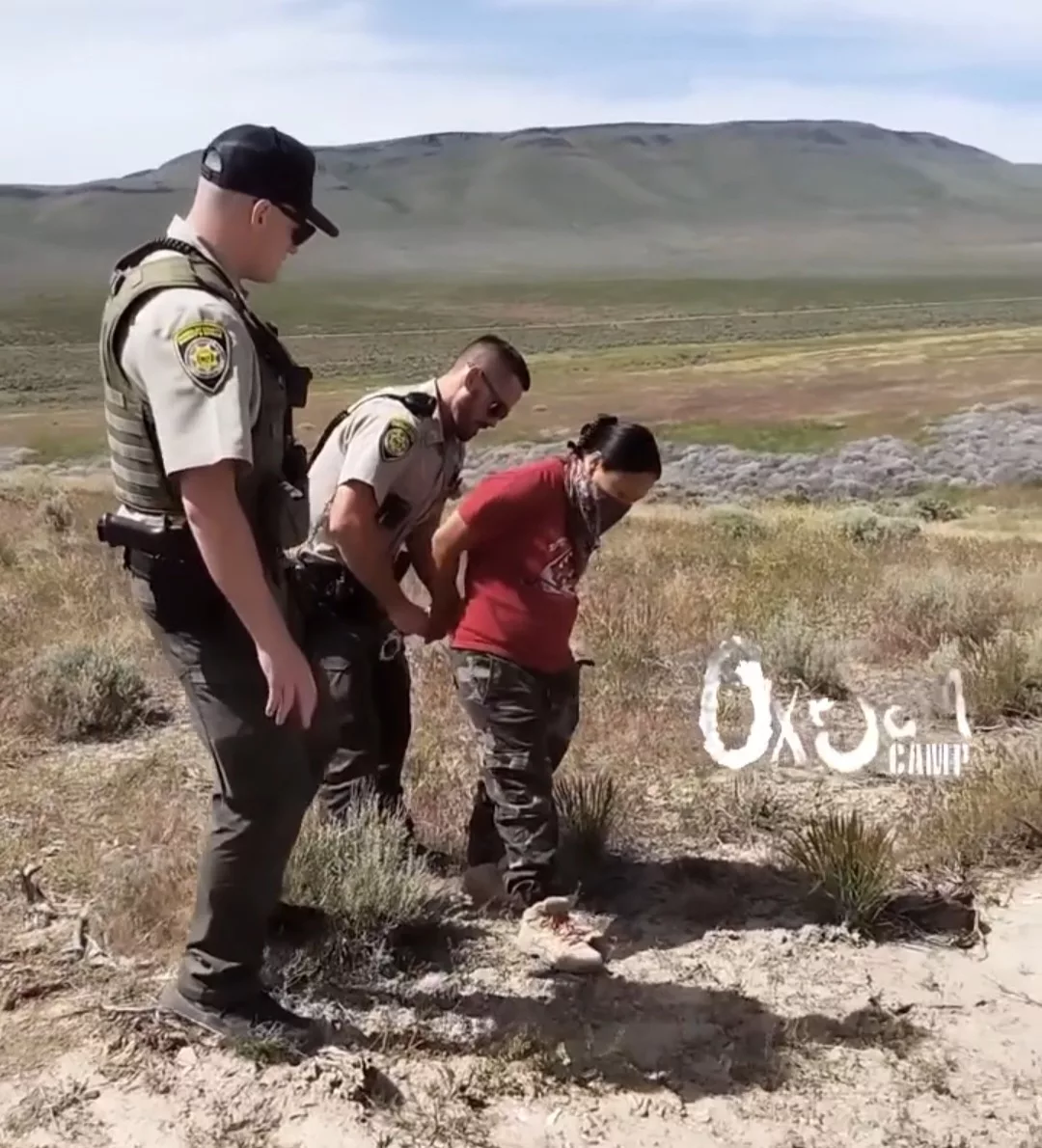

Thursday, June 8th, 2023
Contact: Ox Sam Camp
Email: oxsamcamp@proton.me
OxSam.org
THACKER PASS, NV — On Wednesday morning, the Humboldt County Sheriff’s department on behalf of Lithium Nevada Corporation, raided the Ox Sam Newe Momokonee Nokutun (Ox Sam Indigenous Women’s Camp), destroying the two ceremonial tipi lodges, mishandling and confiscating ceremonial instruments and objects, and extinguishing the sacred fire that has been lit since May 11th when the Paiute/Shoshone Grandma-led prayer action began.
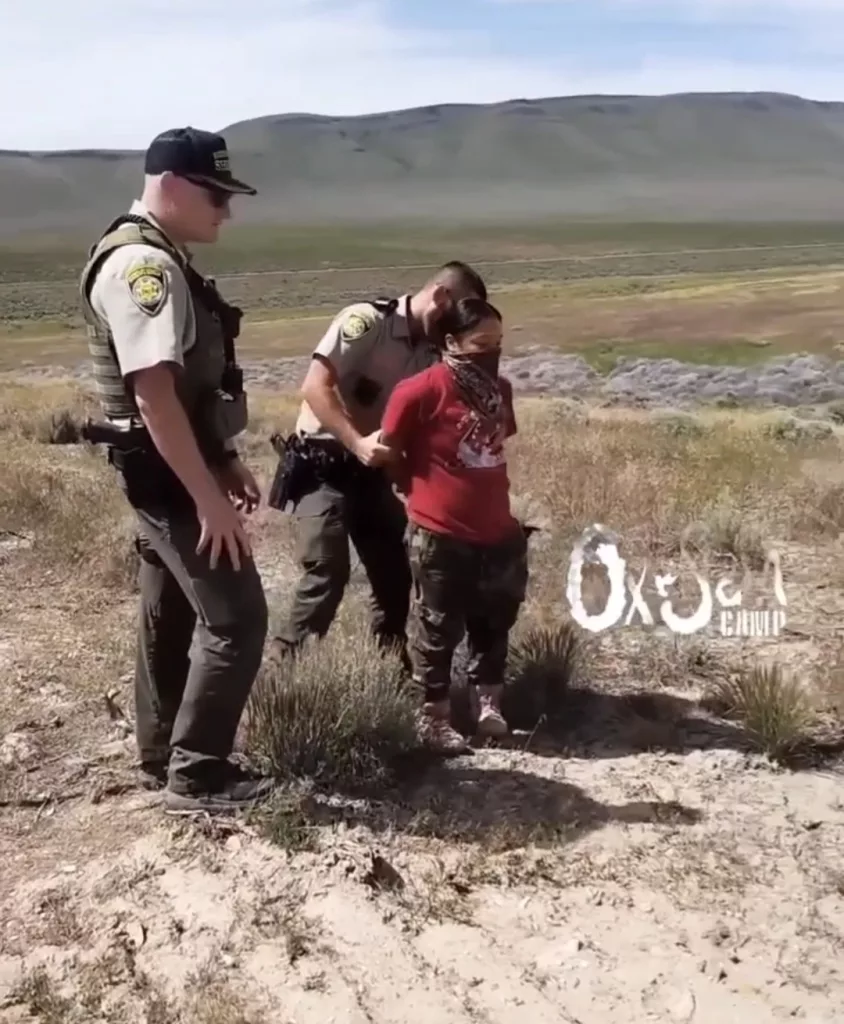

One arrest took place on Wednesday at the direction of Lithium Nevada security. A young Diné female water protector was handcuffed with no warning and loaded into a windowless, pitch-black box in the back of a pickup truck. “I was really scared for my life,” the woman said. “I didn’t know where I was or where I was going, and I know that MMIW is a real thing and I didn’t want to be the next one.” She was transported to Humboldt County Jail, where she was charged with criminal trespass and resisting arrest, then released on bail.
Just hours before the raid, Ox Sam water protectors could be seen for the second time this week bravely standing in the way of large excavation equipment and shutting down construction at the base of Sentinel Rock.
To many Paiute and Shoshone, Sentinel Rock is a “center of the universe,” integral to many Nevada Tribes’ way of life and ceremony, as well as a site for traditional medicines, tools, and food supply for thousands of years. Thacker Pass is also the site of two massacres of Paiute and Shoshone people. The remains of the massacred ancestors have remained unidentified and unburied since 1865, and are now being bulldozed and crushed by Lithium Nevada for a mineral known as “the new white gold.”
Since May 11th, despite numerous requests by Lithium Nevada workers, the Humboldt County Sheriff Department has been reticent and even unwilling to arrest members of the prayer camp, even after issuing three warnings for blocking Pole Creek Road access to Lithium Nevada workers and sub-contractors, while allowing the public to pass through.
“We absolutely respect your guys’ right to peacefully protest,” explained Humboldt County Sheriff Sean Wilkin on May 12th. “We have zero issues with [the tipi] whatsoever… We respect your right to be out here.”
On March 19th the Sheriff arrived again, serving individual fourteen-day Temporary Protection Orders against several individuals at camp. The protection orders were granted by the Humboldt County Court on behalf of Lithium Nevada based on sworn statements loaded with misrepresentations, false claims, and, according to those targeted, outright false accusations by their employees. Still, Ox Sam Camp continued for another week. The tipis, the sacred fire, and the prayers occurred for a total of twenty-seven days of ceremony and resistance.
The scene at Thacker Pass this week looked like Standing Rock, Line 3, or Oak Flat, as Lithium Nevada’s workers and heavy equipment tried to bulldoze and trench their way through the ceremonial grounds surrounding the tipi at Sentinel Rock, and water protectors put their bodies in the way of the destruction, forcing work stoppage on two occasions.
Observers stated that Lithium Nevada’s head of security was directing the Sheriff’s deputies where to go and what to do during the raid.
Lithium Nevada’s ownership and control of Thacker Pass only exists because of the flawed permitting and questionable administrative approvals issued by the Bureau of Land Management (BLM). BLM officials have refused to acknowledge that Peehee Mu’huh is a sacred site to regional Tribal Nations, and have continued to downplay and question the significance of the double massacre through two years of court battles.
Three tribes — the Reno-Sparks Indian Colony, Summit Lake Paiute Tribe, and Burns Paiute Tribe — remain locked in litigation with the Federal Government for permitting the mine. The tribes filed their latest response to the BLM’s Motion to Dismiss on Monday. BLM is part of the Department of the Interior which is led by Deb Haaland (Laguna Pueblo).
On Wednesday, at least five Sheriff’s vehicles, several Lithium Nevada worker vehicles, and two security trucks arrived at the original tipi site that contained the ceremonial fire, immediately adjacent to Pole Creek Road. One camper was arrested without warning, and others were issued with trespass warnings and allowed to leave the area. Once the main camp was secured, law enforcement then moved up to the tipi site at Sentinel Rock, a mile away.
There is a proper way to take down a tipi and ceremonial camp, and then there is the way Humboldt County Sheriffs proceeded on behalf of Lithium Nevada Corporation. Tipis were knocked down, tipi poles were snapped, and ceremonial objects and instruments were rummaged through, mishandled, and impounded. Empty tents were approached and secured in classic SWAT-raid fashion. One car was towed.
As is often the case when lost profits lead to government assaults on peaceful water protectors, Lithium Nevada Corporation and the Humboldt County Sheriffs have begun to claim that the raid was done for the safety of the camp members and for public health.
Josephine Dick (Fort McDermitt Paiute-Shoshone), who is a descendent of Ox Sam and one of the matriarchs of Ox Sam Newe Momokonee Nokutun, made the following statement in response to the raid:
“As Vice Chair of the Native American Indian Church of the State of Nevada, and as a Paiute-Shoshone Tribal Nation elder and member, I am requesting the immediate access to and release of my ceremonial instruments and objects, including my Eagle Feathers and staff which have held the prayers of my ancestors and the Ox Sam camp since the beginning. There was also a ceremonial hand drum and medicines such as cedar and tobacco, which are protected by the American Indian Religious Freedom Act.
In addition, my understanding is that Humboldt County Sherriffs along with Lithium Nevada security desecrated two ceremonial tipi lodges, which include canvasses, poles, and ropes. The Ox Sam Newe Momokonee Nokutun has been conducting prayers and ceremony in these tipis which are also protected by the American Indian Religious Freedom Act. When our ceremonial belongings are brought together around the sacred fire, this is our church. Our Native American church is a sacred ceremony. I am demanding the immediate access to our prayer site at Peehee Mu’huh and the return of our confiscated ceremonial objects.
The desecration that Humboldt County Sherriffs and Lithium Nevada conducted by knocking the tipis down and rummaging through sacred objects is equivalent to taking a bible, breaking The Cross, knocking down a cathedral, disrespecting the sacrament, and denying deacons and pastors access to their places of worship, in direct violation of my American Indian Religious Freedom rights. This violation of access to our ceremonial church and the ground on which it sits is a violation of Executive Order 13007.
The location of the tipi lodge that was pushed over and destroyed is at the base of Sentinel Rock, a place our Paiute-Shoshone have been praying since time immemorial. After two years of our people explaining that Peehee Mu’huh is sacred, BLM Winnemucca finally acknowledged that Thacker Pass is a Traditional Cultural District, but they are still allowing it to be destroyed.”
Josephine and others plan to make a statement on live stream outside the Humboldt County Sheriff’s Office in Winnemucca on the afternoon of Friday, June 9th around 1pm.
Another spiritual leader on the front lines has been Dean Barlese from the Pyramid Lake Paiute Tribe. Despite being confined to a wheelchair, Barlese led prayers at the site on April 25th which led to Lithium Nevada shutting down construction for a day, and returned on May 11th to pray over the new sacred fire as Ox Sam camp was established.
“This is not a protest, it’s a prayer,” said Barlese. “But they’re still scared of me. They’re scared of all of us elders, because they know we’re right and they’re wrong.”
###
Background
Thacker Pass is located in northern Nevada near the Oregon border, where Lithium Nevada Corporation is in the first phase of building a $2 billion open-pit lithium mine which would be the largest of its kind in North America. The lithium is mainly destined for General Motors Corporation’s electric car batteries, which the corporation laughably claims is “green.” Mine opponents call this greenwashing and have stated that “it’s not green to blow up a mountain.”
The U.S. Supreme Court has granted Lithium Nevada corporation and all other business corporations a whole variety of constitutional “rights” that were never meant for business entities. Without these special so-called corporate “rights,” the mine owners would never have been allowed to construct this mine.
Three Native American tribes filed a new lawsuit against the Federal Government over Lithium Nevada Corporation’s planned Thacker Pass lithium mine on February 16, 2023, the latest legal move in the two-and-a-half-year struggle over mining, greenwashing, and sacred land in northern Nevada.
The Tribes notified the 9th Circuit Court of Appeals on May 19th that they mean to appeal their Motion seeking a Preliminary Injunction which was rejected by a lower court in early March. Four environmental groups which lost their case in January have also appealed to the 9th Circuit Court of Appeals, and are expected to be heard in June.
Get updates via email, sign up here:


Indigenous Action Podcast
- Indigenous Action Podcast Ep. 18: No Settler Future An Anti-Year in Review (sorta)
- Indigenous Action Podcast Episode 17: Decolonization isn’t a Holiday
- Indigenous Action Podcast Episode 16: Fuck a Valentine, Indigenous Abolition Feminism
- Indigenous Action Podcast Episode 15: 15th Annual No Thanks, No Giving: Indigenous Anarchism
- Indigenous Action Podcast Episode 14: Queering #MMIWG2ST
Popular Posts
-

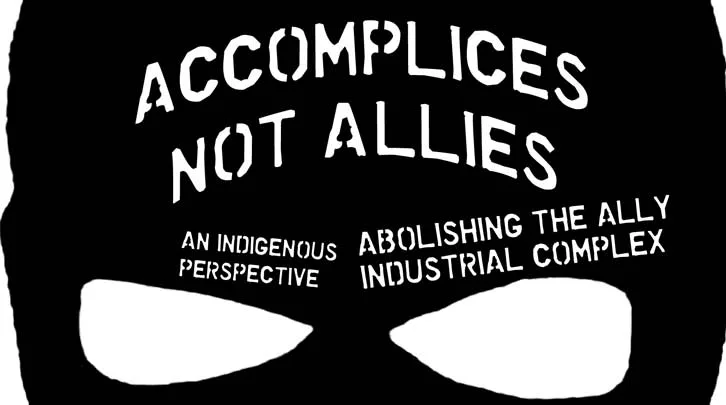

 Commentary & Essays10 years ago
Commentary & Essays10 years agoAccomplices Not Allies: Abolishing the Ally Industrial Complex
-

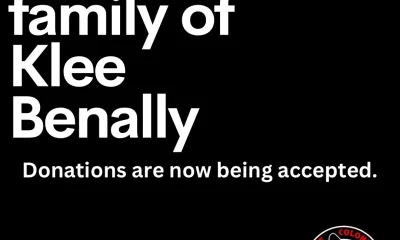

 Feature Front4 months ago
Feature Front4 months agoThe family of Klee Benally thanks you for the donations!
-

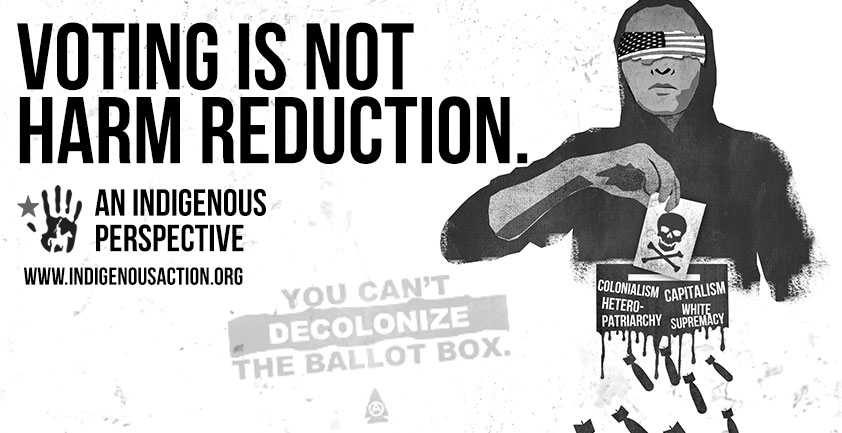

 anti-colonial4 years ago
anti-colonial4 years agoVoting is Not Harm Reduction – An Indigenous Perspective
-



 anti-colonial4 years ago
anti-colonial4 years agoRethinking the Apocalypse: An Indigenous Anti-Futurist Manifesto
-



 #nonukes11 years ago
#nonukes11 years agoIndigenous Elders and Medicine Peoples Council Statement on Fukushima
-

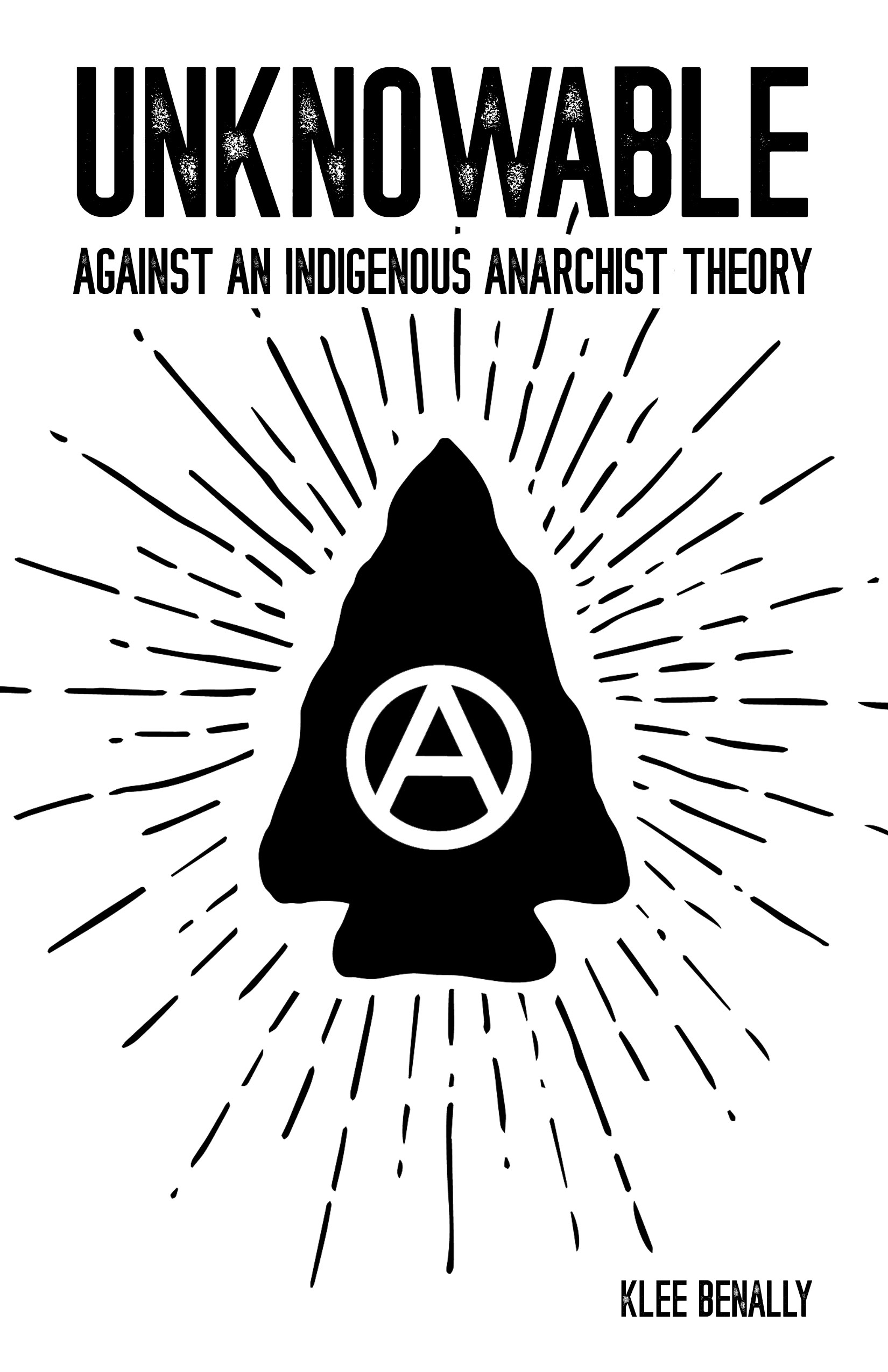

 anti-colonial2 years ago
anti-colonial2 years agoUnknowable: Against an Indigenous Anarchist Theory – Zine
-

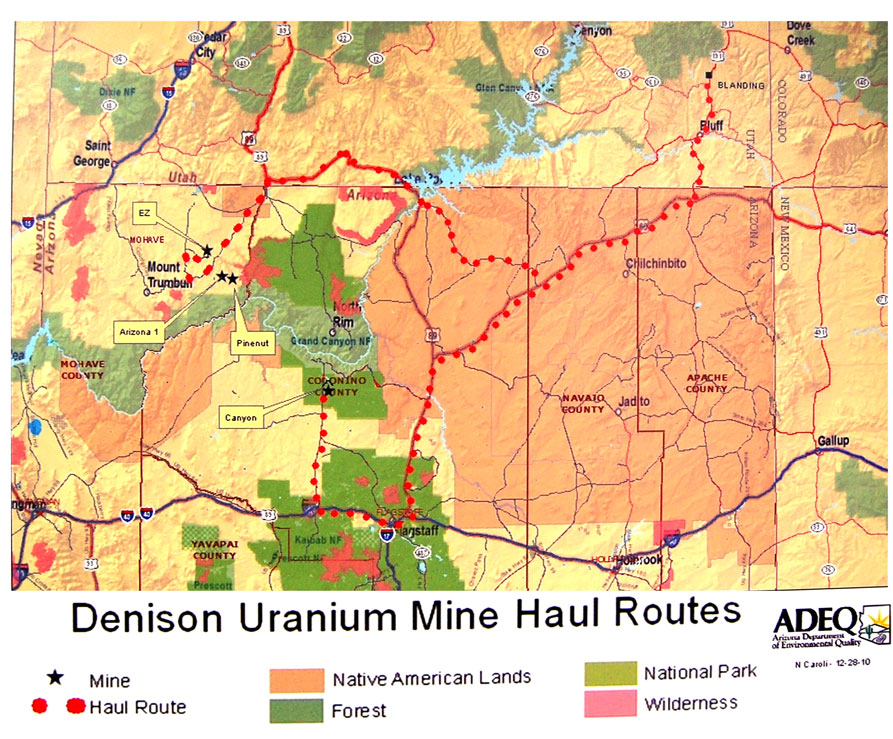

 #nonukes14 years ago
#nonukes14 years agoUranium Mining Begins Near Grand Canyon
-



 anti-colonial6 months ago
anti-colonial6 months agoNew Book: No Spiritual Surrender, Klee Benally

